Sagadahoc Story #68: 11/27/98
Scoping it out
We had a run of pet days before Thanksgiving. Mild, sunny, still.
Made me nervous as a cat, and I scuttled about the quarter acre
yanking up lawn ornaments and stowing the furniture. New moon
and a foreboding of weather. It's putting away time. Now we're
all buttoned up, and the ravens and wolves have the lawn to themselves.
|
Bruce Kaminski rolled in Tuesday lunchtime, with a portrait of
The Toymaker he's just completed. A payback for the Phoenix job
I did on him last month. A story-telling image, and a tour de
force in Renaissance washes and egg tempera. It's a touch dissociative
to face yourself across the room, and at the same time feel defined
and coherent in the paint.
I was intrigued to discover that the persona Bruce captured to
perfection is no longer the who I am. And he doesn't call this
a portrait of me. It's: "The Toymaker." The artist sees this painting
as a mirror for imagining an archetypal role. Geppetto, not Bryce.
|
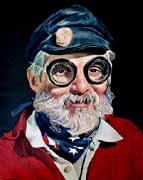
The Toymaker
|
Steve Dunwell, a freelance photo-journalist, did a feature of
me peddling my wares on a street corner in Providence in 1971,
and dubbed me "Bryce the Toymaker." I liked the lyric, and took
up the dance. The whimsical innocence of this calling served me
well, and let me create sculptural images without all the burdens
of curatorial judgment. I was just making toys, not ART. But the
toymaker persona began to wear thin for me fourfive years back,
and it's been hard to assume a new mask. Or put the masks aside.
Seeing my old mask on canvas reminded me how we know ourselves
in this culture. We are what we do, and those doings have a title,
a name and a mythos. Doctor, lawyer, Indian chief. I acted out
a role for 25 years, and put my face on a fable. Now Bruce has
put the finishing touches on The Toymaker, and I can walk away
from it. I hadn't thought of portraits as cathartic.
The wind picked up southerly on Turkeyday, and it was raining
hard by noon. No snow on the coast. We've been spared the first
shovel-out until December. It's got to be close, though, and I
decided it was time to finish Chico's scope stock. I wanted to
have it done before he pushes his plow up the drive.
Good to get back into the sawdust doing something functional.
Some years ago I converted an old gunstock to carry Chico's camera
and long lens. Now he's got a new mega-lens, and asked me to make
a stock to handle both rigs. Took me a couple days of tinker to
devise a mount that would support the different optics, with a
self-lubricated sliding connector made of lignum vitae, a spring-loaded
forward handle, and a trigger-mounted shutter cable. Nice hunk
of black walnut. I rubbed the finish in Thursday morning. Took
the finished product down the hill to Chico's just as it started
to spit.
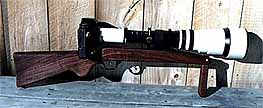
|
He was tickled:
"What do I owe you?"
"You plowing this winter?"
"You've got it." |
So what do I call myself on this one? What's the federal ID number
for jack of all arts? What do I report on the 1040? How many plowings,
at how much per? And what do I pay Uncle with? Walnut chips or
shovelfuls of sand? The whole idea of taxing "underground" income
is a fools errand. You do barter because you don't have cashflow.
Because you're bound together in a gift economy. Trading favors.
But try and explain that to a desk jockey on salary. It's an insult
to our neighborliness to call this trade "income producing." It
insults our intelligence to ask for part of our cash profits.
If it's an even trade, where's the profit? Where's the cash? No
identity and no income? Must be illegal.
Mr. Mann, Marsha and Theo joined us to devour the bird, and afterwards
the ladies flopped down in the front room, Theo dove into the
web, and the guys retired to the shop. I've been rounding up figure
studies from our drawing circle to hang next week, and Mr. Mann
is a fellow traveler in that cadre. So we admired fleshtones in
charcoal, jawed about technique and being artists in the boonies.
We share an uncertainty about names and masks. Mr. Mann has no
titled persona. He won't claim the tag ARTIST. He just is who
he is, without income. But the world asks -- "What do you do?"--
and sometimes it drives him nuts. He hardly ever shows his paintings
and drawings, and gets all torqued at the prospect. Somehow we've
been distracted into believing that real artists have gallery
shows, are represented in museum collections, get critical acclaim.
Publicity means you are. If you don't play with the big boys,
you aren't. Simple being is invisible.
| I suggested we go look at the Portland Museum Biennial Show the
next day, to see what we're missing. Friday morning we filled
the tires in his Hondacar, and buzzed into the big burg. The Biennial
was hyped as the last word on Maine art. Hundreds of regional
artists applied, and none of our friends were accepted. The jury
was a trio of sophisticated urbanites, well-versed in curatorial
fashions. Here was a chance to glimpse what an outside eye sees
as the best of our provincial offerings. |
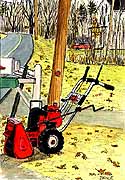
Snowblower
|
We were underwhelmed. As always at group shows there are artists
whose work is technically masterful. And a few works that speak
right into you. But the collection is a hodgepodge whose only
unifying thread seems to be a concern for unusual effects. Is
that what real art has come to? Quirky takes. These may be talented
Maine artists, but you could hunt a long time for any Maine content.
If there was a Maine ethos in the work, it was hidden by the smoke
and mirrors. Of course that wasn't what the organizers were looking
for. They wanted to showcase provincial artists doing the contemporary
thing well. Art, you might conclude, is a motley of individual
visions in a sophisticated language.
The idea of a regional sensibility must seem strangely anachronistic
to the cognoscenti in a media age. Who needs local art in a global
village? But I'm reminded of the later works of Grant Wood and
Thomas Hart Benton and Bernard Langlais. World talents who shrugged
the acclaim game to be artists of place. You might put Winslow
Homer on that list, too. I think they saw that local art is precisely
what we need to ground us. If art teaches us to see the extraordinary
in the ordinary, a collection of the unusual defeats its purpose.
I was amused to see that when the Biennial featured artists working
the Maine vein, the examples they chose to show were notably abstracted,
extraordinary. Maybe that's as close as the overheated ART world
can get to a local view. The only works that said "right here"
had rocks in them, or trees.
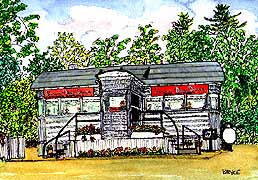
Sunny Day Diner
|
Mr. Mann came away cheered. Some of his work could have fitted
right in without a blink. So he's not living in a bubble. I don't
see where what I'm doing has anything to do with the museum culture.
And that pleases me. It's fun to feast your eyes on haut cuisine,
but I guess I'm a local diner kind of guy.
|
Over Thanksgiving week the town has been full of returnees. Folks
who've followed the yellow brick road to affluence and away. Home
for the hols, and out hunting. The herd is blooming, and everyone
seems to be getting his deer. It's kinda poignant to see these
beenaway guys in wool and blaze orange doing the pickup standaround.
You know their lives are full of pavements and paperwork and this
is the one escape of the season. For all their obvious affluence,
they look comfortably down home, out jawing in the parking lot
in plaid caps. Did they buy into the American Dream, like successful
artists who go away, only to hunger for a taste of venison? Is
that why they drive SUVs? Is their view of life blurred by a craving
for success and acclaim?
| Jimmy and the boys are hauling in slabwood and moving smelt camps
around. They aren't wearing LLBean labels. The ice may be late
again this year, but it's time to start mending shanties. The
seasonal music around here is chainsaws bucking stovewood. I'll
be glad when this waiting time is over, and the river knits up. |
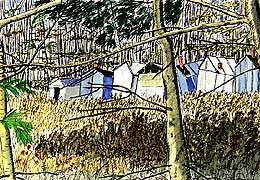
Chubby's Camps
|




